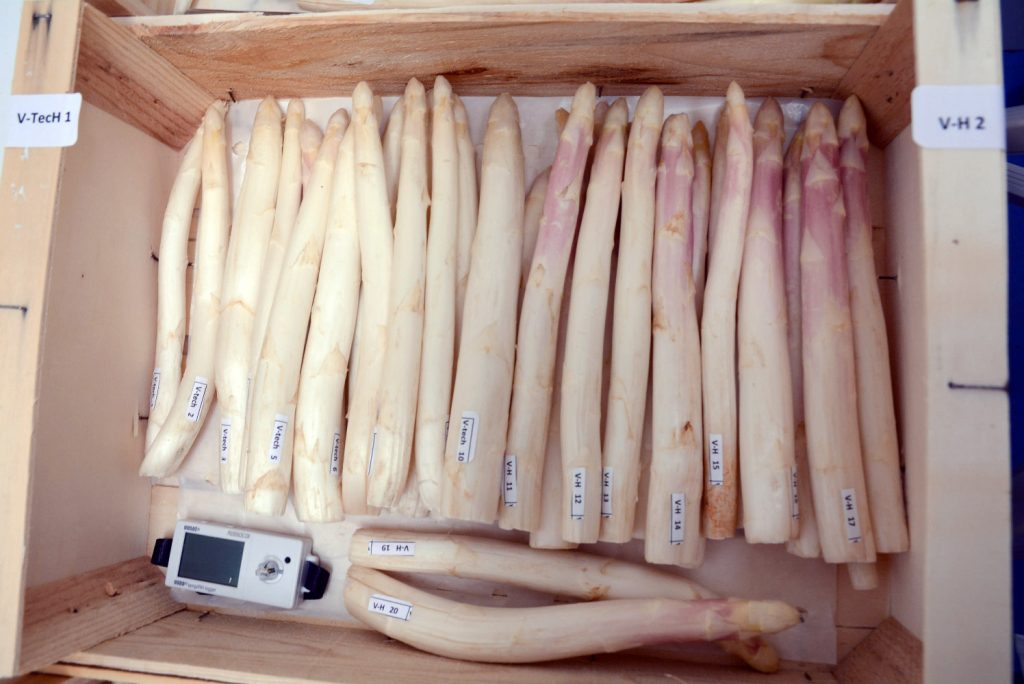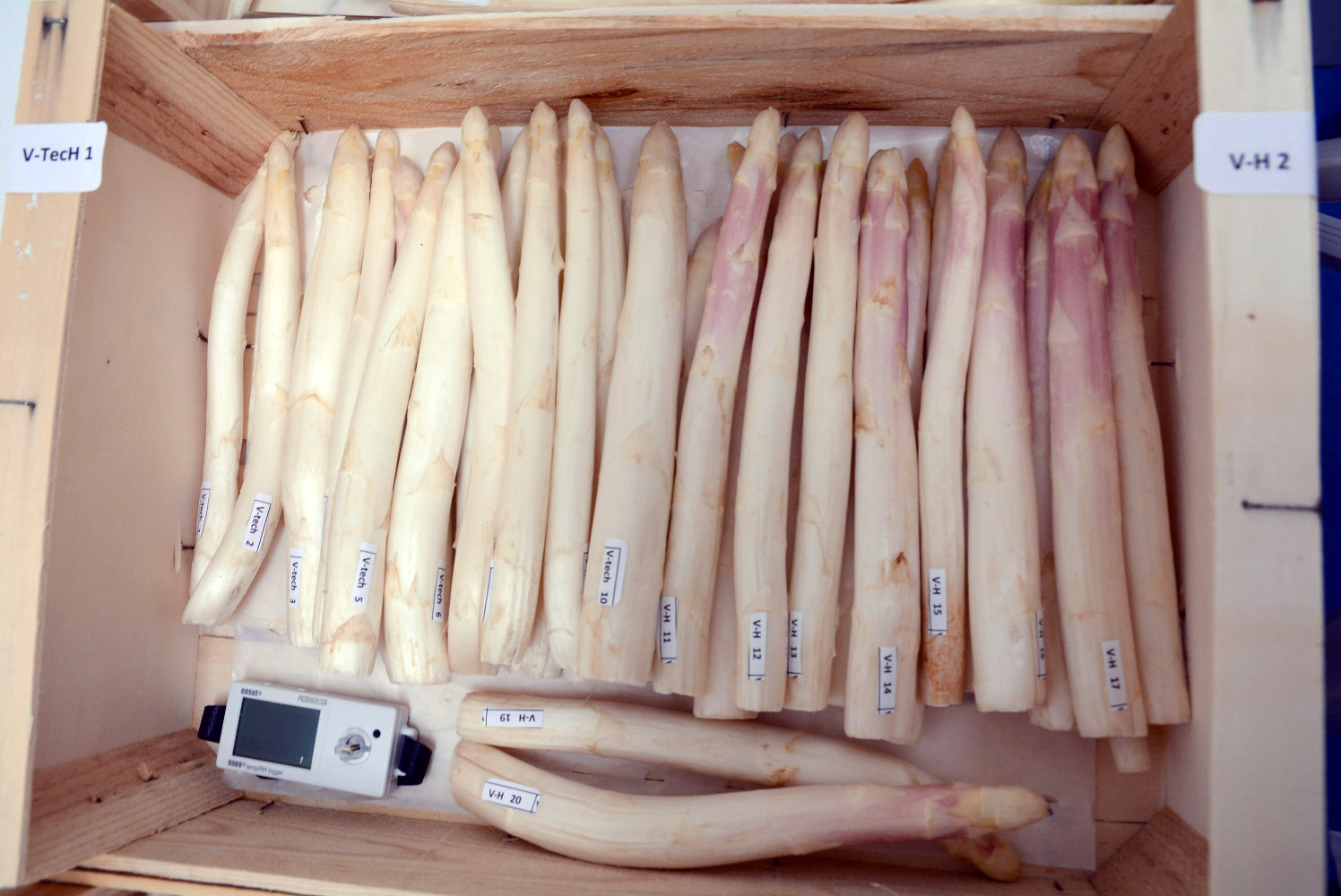White asparagus – A hot water treatment to limit postharvest pink discolouration ?
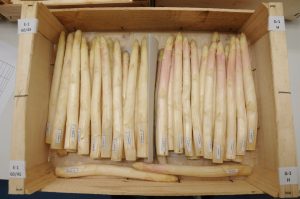
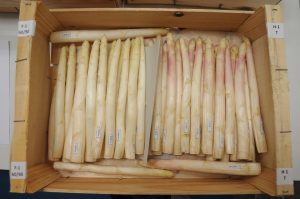
After harvest, white asparagus undergoes physiological and biochemical changes that rapidly lead to a loss of quality. The main effects are higher fibrosity, water loss, and the development of a pink discolouration due to an increased synthesis of anthocyanins. The pink discolouration is a criterion that depreciates product quality and, depending on the distribution channel, may entail downgrading to a lower class, with a possible price loss of 5 to 15% for the grower, according to a survey by CTIFL (2017).
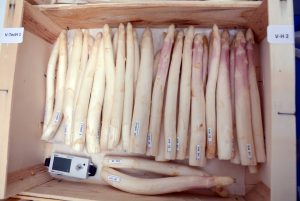
Spears immersed in hot water show practically no pink discolouration
Several studies have shown the advantage of rapidly lowering the temperature of asparagus with cold (6-8°C) or iced water by spraying or immersion (hydrocooling) in order to delay the appearance of this pink tint. In an article published in Infos Ctifl nr. 353 (July 2019), Patricia Sanvicente, Sophie Annibal and Valérie Mérendet write that « rapid cooling after harvest is currently the most widely used technique in France ». Based on literature (see boxed text), new studies were conducted by CTIFL in 2017 and 2018 in order to assess the interest of hot water treatments applied to white asparagus varieties. Thus, in 2017, the hot water treatment of the varieties Darlise (little susceptible to pink discolouration) and Vitalim (highly susceptible) was applied by immersion of the spears, followed or not by a hydrocooling treatment using spraying. The core temperature of the spears during the trials was maximum 47-50°C for immersion treatments at 55 °C. The spears returned to their initial temperature after 30 minutes at room temperature (18 °C) or were cooled to the core at 3° C in less than an hour if the hot water treatment was followed by hydrocooling (2 °C/20 min). In the trials, the spears immersed in hot water showed practically no pink discolouration, whereas the control spears, hydrocooled and immersed in water at room temperature, took on a pink tint after 5 to 6 hours in simulated point-of-sale conditions, with the discolouration further evolving over the three days of exposure to light (Figure 1). As the authors observe, « pink discolouration of white asparagus is strongly delayed by immersion in water at 55 °C ».
Towards a large-scale implementation?
In the experiments, techniques combining a hot water treatment applied by dipping or spraying within 3 or 4 hours after harvest, followed by hydrocooling or immersion in temperate water (Mérendet & Annibal 2015) offer the best compromise in order to limit pink discolouration and water loss. Using this method, the core temperature of asparagus decreases rapidly and the spears are quickly cooled down before storage. As the authors of the article state, « Before those techniques can be applied on a large scale, the growers will have to confirm the feasibility of introducing the various steps into the organisation of the packing stations, as well as the positioning of the existing equipment. ». If one of the two proposed methods is deemed to offer perspectives for implementation, the advantage of a hot water treatment will have to be validated at the grower’s facility using existing or specifically adapted equipment.
Why does white asparagus turn pink?
Anthocyanins are pigments that filter light; they accumulate in plant tissue in response to the action, joint or separate, of various environmental factors, such as light (Leyva 1995), low temperatures (Christie et al. 1994, Dixon 1995) or nutritional stress, e.g. a phosphorus deficiency (Kakegawa et al., 1995). As a reaction to those factors, the activity of phenylalanine ammonia-lyase (PAL), a key enzyme in the pathway of anthocyanin biosynthesis, is stimulated (Dixon 1995, Flores et al, 2005). In the case of white asparagus, research indicates that there is an increase in the activity of PAL, and therefore enhanced postharvest anthocyanin synthesis, after an initial stimulation by light, independently of temperature and lighting conditions during storage, thus causing the appearance of a pink tint (Siomos et al. 1994, Siomos et al. 1995a, Siomos et al. 1995b; Siomos et al. 2000; Siomos et al. 2001, Flores et al. 2005).
Existing data
Research in the Netherlands showed that a hot water treatment (50 °C/2 min) limits the appearance of a pink tint in white asparagus (Poll 1998). More recently, Siomos and his team (2005, 2010) confirmed that, in experimental conditions, heat treatment by immersion in hot water is efficient in preserving the white colour of asparagus spears. A treatment by immersion in hot water at 55 °C for 2 to 3 minutes, followed by an immersion in water at room temperature for 10 minutes, is efficient against pink discolouration in the varieties Atlas and Dariana. Similar results were obtained in preliminary research conducted by CTIFL in 2015 on the variety Grolim (Mérendet & Annibal 2015).
Spraying or immersion?
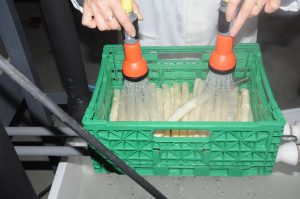
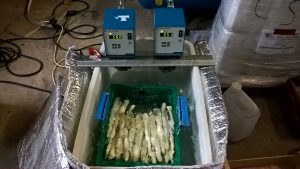
In 2018, hot water spraying was tested by CTIFL in order to determine if this method was as efficient as immersion in limiting the appearance of a pink tint in asparagus. The technique was assessed using several combinations of temperature/duration, systematically followed by hydrocooling through immersion (1 °C/5 min). In the spraying treatment, asparagus spears in plastic crates were placed under two spraying nozzles supplied with water heated and regulated at the desired temperature. As in the « immersion » trials, the spears in the « control » batch and the « hydrocooled » spears took on a faint pink hue within a few hours of their transfer into point-of-sale conditions. After 24 hours in said conditions, 90 to 100 % of the spears showed a fairly marked pink discolouration (colour index 70 to 80). However, spraying with hot water 3 to 4 hours after harvest, followed by hydrocooling through immersion, limited the appearance of a pink tint. The best results for each tested treatment temperature were obtained with the longest exposure. On the other hand, a heat treatment 24 hours after harvest was less efficient than a treatment within 3 or 4 hours after harvest. In the experimental conditions, the temperature/duration combination of 58 °C/90 sec was the most efficient to avoid pink discolouration of the spears. Unlike the results of the « immersion » trials, which showed a very slight dehydration of the spears (0,1 to 0,2 %), the heat treatments using spraying did not entail any weight loss. On the contrary, the spears gained an average of 2 % of their initial mass by absorbing water during the treatment.






